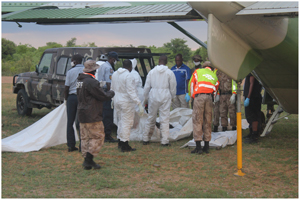
DNA samples of crash fatalities

The crash victims’ bodies were ferried by helicopter from the crash site to a landing strip from where they were taken by aeroplane to Windhoek. (Photograph contributed)
Flight TM470 from Maputo was bound for Luanda when it was reported missing on Friday, 29 November 2013.
The plane was later discovered after the Mozambican Airlines, LAM received confirmation from the Namibian Civil Aviation Authority that the search party and its inspectors have located and identified the aircraft wreckage at Bwabwata.
At least 33 bodies where retrieved from the crash scene and transported to the Rundu mortuary before airlifted to Windhoek. On board were six crew members and 27 passengers, of whom ten were Mozambican, nine Angolan, five Portuguese, a Portuguese-Brazilian, one French national and one Chinese national.
“Namibia, as the country where the accident occurred, will lead the investigation,” the airline said in a statement.
LAM sent a team of experts and also asked Kenyon International, specialists in disaster recover, to deploy to Namibia.
Other investigators will be drawn from Angola, Brazil Mozambique and the US National Transport Safety Board.
The International Criminal Police Organization, INTERPOL will also assist in the investigation. The investigation process consists of two phases, first the reconstruction of the events leading to the crash landing and second, the identification of the mortal remains of the victims. The air- crash investigation will attempt to reconstruct and determine the cause of the accident while the disaster victims identification process will aim at reconciling the identities of the victims. At a press briefing held this week, Inspector General of the Namibian Police Force, Lt Genl Sebastian Ndeitunga said the disaster victim identification process will focus on gathering ante-mortem data of the missing persons whilst the post-mortem data collection and analysis will aim at matching the validated results in order to identify all the remains accordingly. Although procedures are in place to collect DNA samples from family members, so far the investigating team in Namibia has not received all samples from the affected families. Ndeitunga said becasue of the devastating effect on the bodies, the remains of the deceased can not be identified visually. He called on family members to provide all relevant data and samples to ensure the identification is accomplished on time. The plane was a Brazil-manufactured Embraer 190 jet and the newest plane in the airline’s fleet.











































